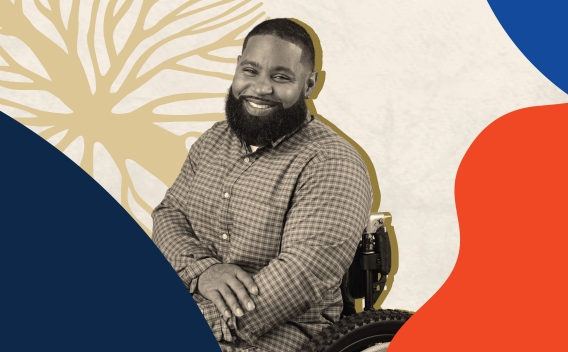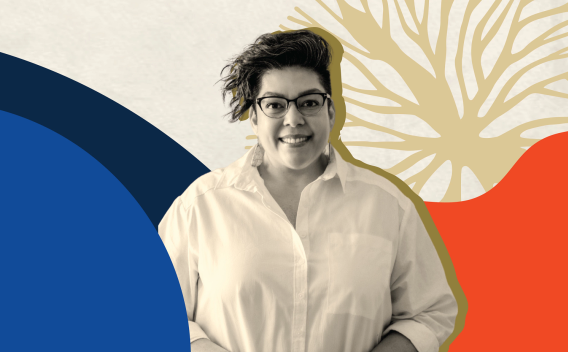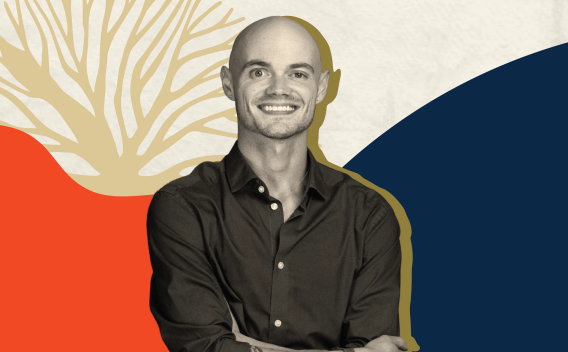By
Published
January 23, 2024
Tags
SUMMARY:
As Executive Director of CROP (Creating Restorative Opportunities and Programs), Terah Lawyer draws from her lived experience to support rehabilitation and reentry for people leaving incarceration. This interview explores Terah’s journey from incarceration to criminal justice leadership and her insights on building a more empowering and successful reentry system.
This interview is part of Roots to Branches, an ongoing series featuring conversations with leaders working to build a more just and inclusive world. The series highlights the unique journeys that brought these leaders to where they are today and their visions for the road ahead. To explore more conversations in the Roots to Branches series, check out Schusterman’s digital magazine, Toward.
In 2015, Terah Lawyer (she/her) made a promise to herself: “From now on, my life belongs to my community.”
At the time, that community included other people incarcerated at a California state prison, where Lawyer was serving a 15 years to life sentence. Lawyer had already achieved so much while incarcerated; she became a peer health educator, a licensed drug and alcohol counselor, and earned two associate’s degrees. Her commitment to serving and strengthening her community in prison led her to launch a nonprofit, Criminal Offender Reform Establishment (CORE), and develop the Offender Responsibility Program, which is still active at Central California Women’s Facility.
But when she was released from prison in 2017, Lawyer’s community grew more than she ever anticipated.
I spoke with Terah to learn more about how her experience has informed her leadership as Executive Director of Creating Restorative Opportunities and Programs (CROP), and how CROP is working to transform correctional facilities into restorative places while helping formerly incarcerated individuals successfully reenter their communities.
What was your journey to joining CROP?
I have always wanted to stand up for others who were treated badly because they were different. But my journey to working on criminal justice reform really began when years of trauma and my own poor choices led me to become part of a subculture often excluded by mainstream society: incarcerated people.
So much of life in prison is upside-down. The correctional system does not approach rehabilitation in a positive, healing, human-centered way, and I wanted a safe, restorative place for me and the women around me to explore what led us there and what goals we had so that we could begin to change our lives. But the fact is that for every woman incarcerated, there are 10 men—so there are very few rehabilitation services specifically for women.
Supporting Holistic Reentry
Based in Los Angeles and the Bay Area, CROP provides holistic reentry programming designed to equip justice-involved people with the workforce training and skills they need for success.
I figured if I was potentially going to spend my life in prison, I was going to change this. I became chair of the Beyond Incarceration program and worked with one of my college professors, my warden and a local pastor to form the first-ever California Youth Diversion Program, an opportunity for us to use video conferencing and in-person visits to speak with high school kids across the state about our experiences. I also launched a nonprofit, Criminal Offender Reform Establishment (CORE), and developed the Offender Responsibility Program.
Then, when I was paroled in 2017, I quickly saw how disjointed so many of the services were for those recently released. By the grace of God, I was able to get work with the American Friends Service Committee as an intern. I then began working with Impact Justice to build out the organization's Homecoming Project, which became my baby. Since its inception, the program has been able to place over 100 formerly incarcerated people in stable housing to date.
It was while I was working on the Homecoming Project that I was approached by the Executive Director of CROP at the time. He and I had stayed in contact after I helped him find housing years before. He was moving on and said they needed someone with my experience. I took the job after thinking long and hard about what my impact could be with CROP, and I’m proud to say that we have achieved some amazing things.
“We know exactly how much it costs to incarcerate someone, but we have no idea how much it costs to successfully re-integrate them into society.”
What are the biggest challenges you see in your work?
We know exactly how much it costs to incarcerate someone, but we have no idea how much it costs to successfully re-integrate them into society. Individuals coming out of prison have a lot of needs—food, clothing, housing, job training and so much more—and the system for meeting them is so hard to navigate. When a person leaves prison, they need to go to 10-20 different service providers just to try and meet their needs.
I’ll share my experience as an example: I had to have housing to be paroled, so I applied to 100 different reentry housing programs. Three got back to me. I had to go to about 15 different organizations to get my basic things like employment and clothing. Then, when I was living in my reentry housing, I had to go through mandatory drug and alcohol counseling, even though I was a certified drug and alcohol counselor myself. I couldn’t drive while in the program, even when I got my license reinstated. And even though I had a job offer from a community organization before I was released, they had to rescind it because I wasn’t allowed to work for three months once I got out.
Not only is this one-size-fits-all approach a waste of resources, but it also holds people back from true reentry instead of empowering them. The challenging thing is that so many individual groups are providing different services for formerly incarcerated people.
At CROP, we aim to help address this issue through our signature reentry program, Ready 4 Life, which equips formerly incarcerated individuals with 12 months of comprehensive, wraparound support. During this program, we leverage existing services and centralize them so our participants can navigate everything they need to reenter their communities successfully.
Finding Housing After Incarceration
In an episode of the podcast, The Untold Story: Criminal Injustice, leaders at our grantee organizations speak about how to increase housing access for people who have been involved in the justice system.
What changes are you working toward this year and in the long term? What does success look like for CROP?
This year, we’ll be at full capacity in both of our Ready 4 Life office locations, and we’re aiming to get our numbers standardized so we can understand exactly how much it costs per participant to run this program. We’re doing a lot of strategic advocacy to get the support of elected officials and expand statewide.
Longer-term, another goal is to purchase our Bay Area West Oakland Career Campus building and put those long-term rent savings back into program work. We also plan to partner with the state of California on licensing our data platform to other reentry programs so that the state can have a centralized system for collecting data across these service providers and better assess how to help the most people successfully reenter society.
What trends or changes in the criminal justice reform and reentry spaces are giving you hope?
Governor Gavin Newsom’s intention to redesign what prison might look like in California is a huge leap in the right direction. There’s a real push to convert prisons into actual rehabilitation facilities, where people can learn how to lead a life without crime and, therefore, without being continually punished and retraumatized. Instead of pulling them further into a downward spiral, it could help them be their best selves. I’m privileged to be a part of the governor’s Transformative Justice Council advising this effort, and I look forward to seeing what kind of progress we can make.
What lessons do you feel are most important to share with new leaders working for criminal justice reform?
If you’re a leader in this space, never assume your lived experience is the only experience. For example, I was released before the COVID-19 pandemic. I have no idea what someone released after 2020 is going through. Get as many voices in the room as possible and lean on collective decision-making as much as you can.
Being a Black person, being in the queer community, being formerly incarcerated, being a woman—I know all of these aspects of my identity are not nearly enough to represent the diverse beauty within our society and among those incarcerated. However, it does keep my mind open enough to realize that there is no one-size-fits-all solution. Use and leverage your identifiers to bring more people to the table and build out a more equitable reentry system.
Charles and Lynn Schusterman Family Philanthropies welcomes the expression of personal thoughts and reflections in Toward, our digital magazine. Each post reflects the opinion of its author and does not necessarily represent the views of our organization or our partners.





